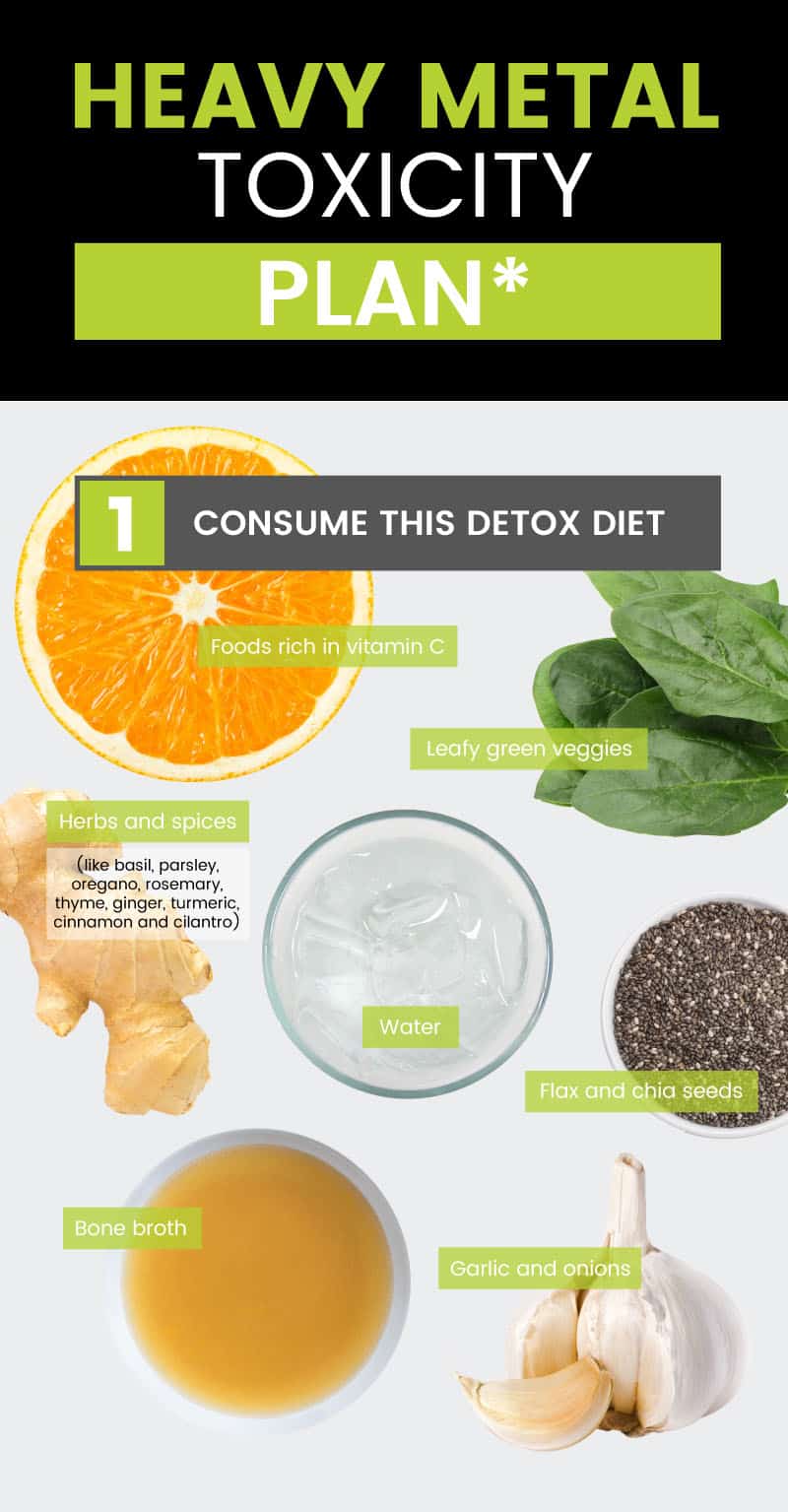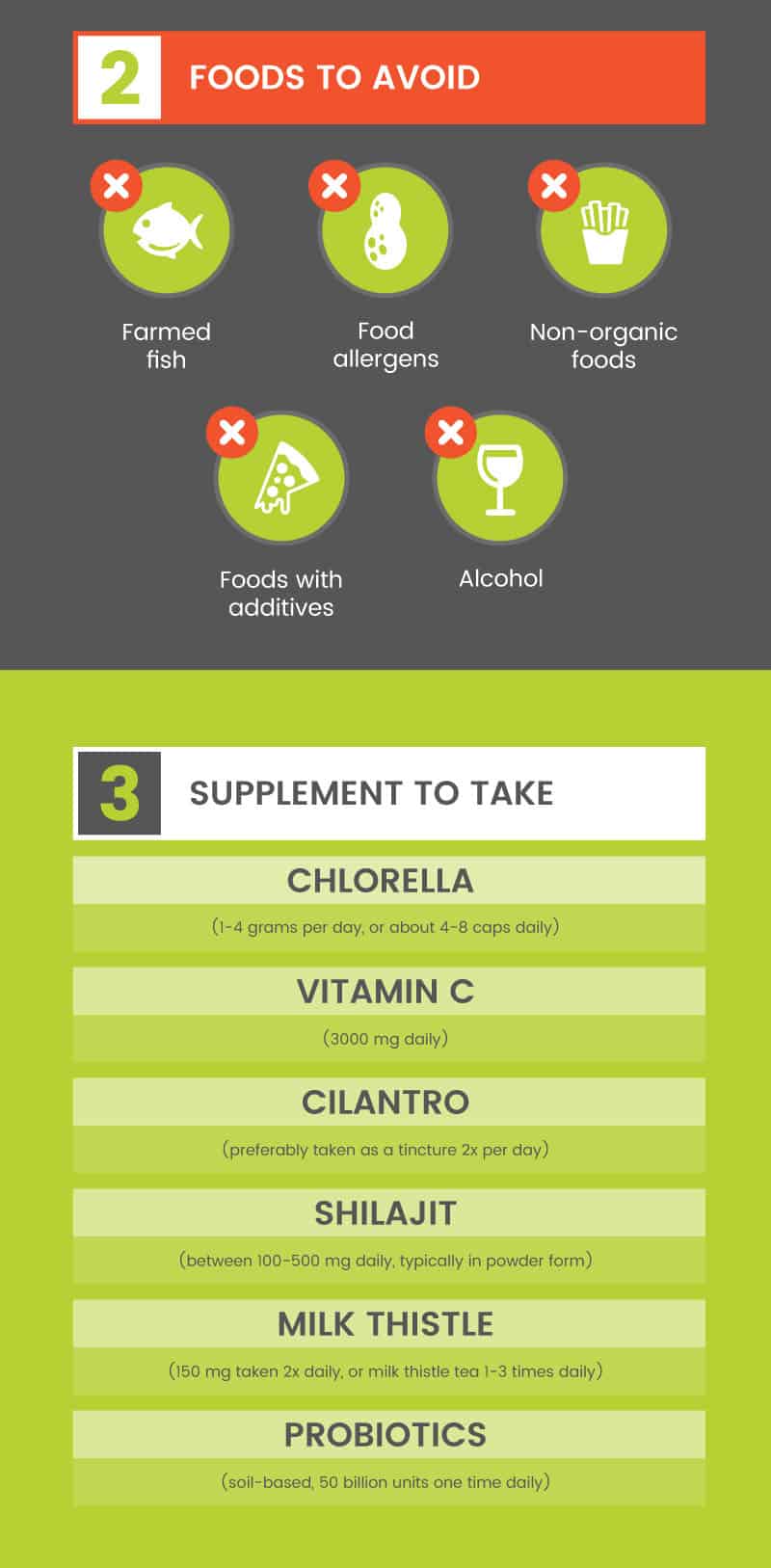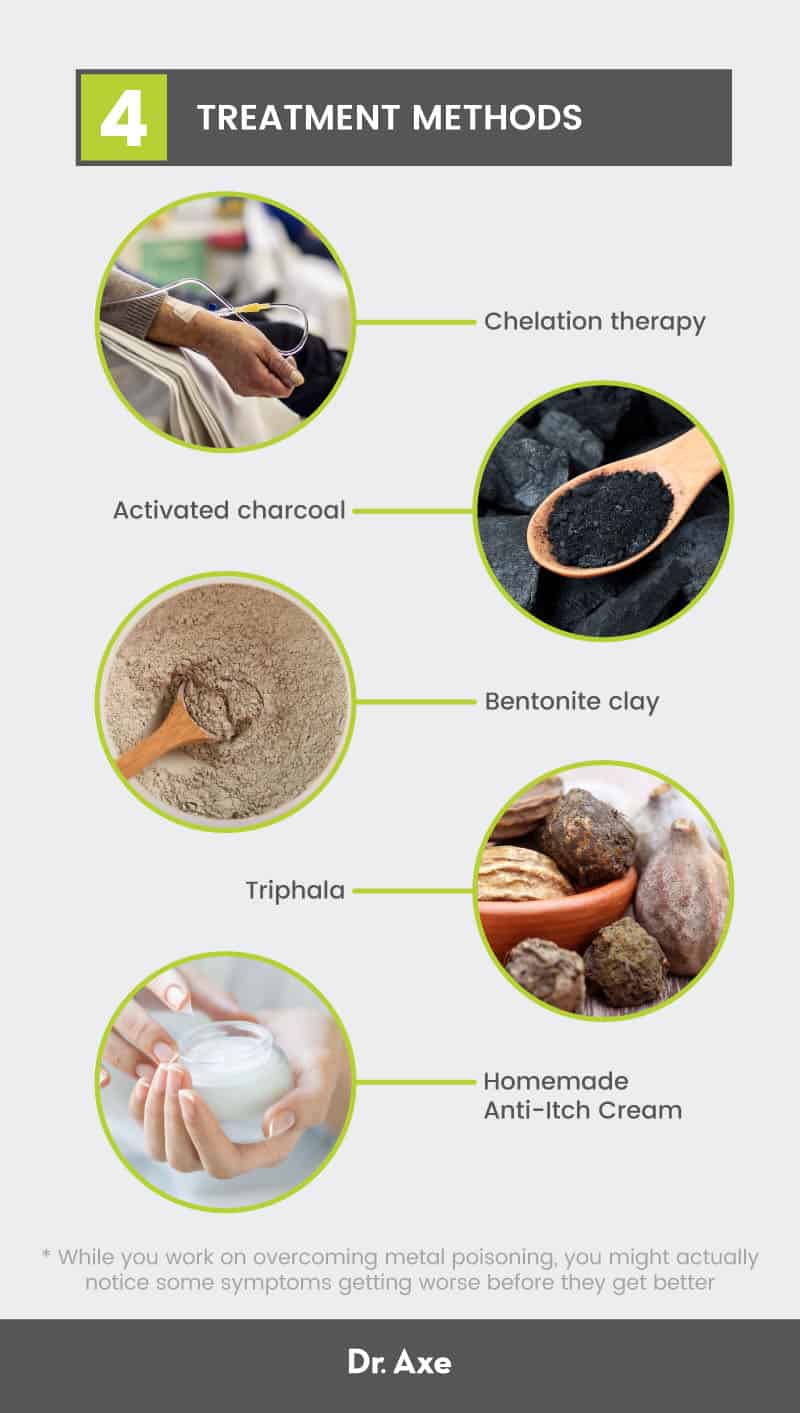Dangers of Heavy Metals & Detoxing Tips
- Dangers of Heavy Metals
- Signs and Symptoms of Heavy Metal Poisoning
- Where Do Heavy Metals Come From?
- What Is a Heavy Metal Detox?
- Heavy Metal Detox Diet
- Detox Recipes
- How to Deal with Symptoms
- Precautions and Side Effects

Symptoms and even chronic diseases related to heavy metal toxicity (also known as heavy metal poisoning) are now considered to be a problem that millions of people deal with. Incorporating a heavy metal detox into your routine from time to time is of utmost importance.
Exposure to toxic heavy metals is believed to be a contributing factor, if not the root cause, to symptoms such as low energy, mood disturbances, and cognitive changes.
Heavy metals initially enter your bloodstream through exposure to farmed fish, contaminated water, dental fillings, and household products. Then, they travel throughout your body and penetrate the cells of various tissues and organs, where they can remain stored for years!
How do you treat heavy metal toxicity? Following a heavy metal detox plan is one of the best ways to start reversing symptoms.
However, it’s important to note that while working on overcoming metal poisoning, you might actually experience some symptoms getting worse before they get better. Potential heavy metal detox symptoms can include fatigue, loss of appetite, and digestive issues.
What foods can help remove heavy metals from the body? As you’ll learn more below, foods to include during a heavy metal detox are leafy green veggies, other non-starchy veggies, herbs, spices, algae, bone broth, and other superfoods.
Detoxifying treatments and certain supplements can also be incorporated into a natural heavy metal detox diet plan to support your brain, nervous system, liver, and other vital organs.
Want to learn how to detox your body from heavy metals and other chemicals? Follow the heavy metal detox diet and treatment plan described below to help rid your body of toxins.
Dangers of Heavy Metals
What exactly are “heavy metals”? Heavy metals are elements that can be toxic and extremely dangerous even in low concentrations.
Heavy metals that can lead to toxicity (or “poisoning”) include:
- Mercury
- Lead
- Arsenic
- Cadmium
- Aluminum
- Nickel
- Uranium
- Thallium
Other definitions also include manganese, iron, lithium, zinc, and calcium. (Yes, under certain conditions, very high levels of even essential minerals can become dangerous.)
Heavy metal poisoning describes a number of health problems caused by exposure to environmental metals that accumulate inside the body. According to a report in Scientific World Journal, “Toxic metals such as arsenic, cadmium, lead, and mercury are ubiquitous, have no beneficial role in human homeostasis, and contribute to noncommunicable chronic disease.”
Researchers have identified that significant exposure to at least 23 different environmental metals (referred to as “heavy metals”) can contribute to acute or chronic toxicity. These metals are described as being heavy because they stay in the body for a long time, especially hiding out in adipose tissue (fat cells). They are difficult to get rid of, making them similar to fat-soluble toxins.
Body fat tries to protect the organs by trapping certain substances, including some metals, inside, which causes them to linger. This is one reason why weight loss can sometimes result in heavy metal detoxing, as fat cells shrink and release dormant toxins.
There is virtually no way to completely avoid heavy metal exposure, considering metals are natural elements found in the food supply, water, and ground all over the world. Environmental metals are problematic because over time they can accumulate within bodily tissues, often without the affected person even realizing this is happening. Heavy metal toxicity can lead to damage or reduced mental and central nervous function, as well as damage to vital organs such as the liver, heart, endocrine glands, and kidneys.
Long-term exposure to heavy metals may lead to physical, muscular, and neurological degenerative processes. When it becomes severe, heavy metal poisoning symptoms can even mimic symptoms associated with Alzheimer’s disease, Parkinson’s disease, and multiple sclerosis.
Because heavy metal poisoning symptoms resemble those related to aging (such as memory loss and increased fatigue), many people attribute their emerging symptoms to getting older instead of realizing that heavy metal exposure is a major contributing factor.
In addition, heavy metals in foods like arsenic, lead, and cadmium have been linked to several forms of cancer in multiple studies, including lung, kidney, bladder, stomach, brain, skin, liver, prostate, renal, breast, pancreatic, and endometrial cancers.
They were also associated with risk factors for reproductive, neurological, renal, respiratory, hematopoietic, skin, cardiovascular, immunological, and developmental issues.

Signs and Symptoms of Heavy Metal Poisoning
Some of the most common warning signs that you might be struggling with heavy metal toxicity include:
- Chronic fatigue
- Autoimmune diseases, including Lyme disease
- Poor recovery from exercise and weakness
- Skin irritation
- Neurological disorders
- Brain fog, trouble concentrating, difficulty learning, and poor memory
- Depression, manic depression, and/or anxiety
- Dementia
- Insomnia
- Digestive issues, such as irritable bowel syndrome
- Chronic aches and pains, such as those associated with fibromyalgia
- Tremors
- Impaired motor control, hearing, speech, vision, and gait
- Anemia
- Higher risk for heart attacks
Where Do Heavy Metals Come From?
Mercury poisoning is one of the most common types of heavy metal poisoning.
Almost every person in the world has at least trace amounts of mercury in their body. Why? Some of the factors that can cause mercury poisoning (and other types of heavy metal toxicity) include:
- Exposure to environmental pollutants such as traffic fumes, air pollution, food contaminants, cigarette smoke, or radiation.
- Having metal amalgam dental fillings. (Silver fillings slowly release mercury into the body.)
- Eating a poor-quality diet (for example, eating farm-raised fish that carry high levels of mercury). According to the Environmental Protection Agency, the most common way we’re exposed to mercury in the US is by consuming fish you shouldn’t eat that contain health-hazardous heavy metals, such as tilefish, swordfish, shark, king mackerel, and bigeye tuna. A diet that includes processed foods, especially those imported from foreign countries and not organically grown (and even plant foods grown in soil with high metal levels), can also be a contributing factor.
- Drinking water that is contaminated with trace amounts of metals (such as aluminum).
- From birth. (Heavy metals can be passed down from mother to her offspring in utero.)
- Exposure or use of household substances that contain mercury, such as adhesives, air condition filters, cosmetics, fabric softeners, felt, floor waxes and polishes, and talcum powder.
- Getting tattoos.
- Exposure to substances that carry lead, such as some chocolates, canned foods, toothpastes, old paints, insecticides, ceramic, and some pottery, and soldered pipes.
- Use or exposure to other household items, such as antiperspirants, baking powder, certain baby formulas, plastic toys, antacids, aluminum foil, certain metal pots and pans, stainless steel cutlery, coins, and some makeup.
In high amounts, mercury is one of the deadliest metals. Certain studies have found that when nerves are exposed to mercury, the myelin sheath (the fatty substance that surrounds the axon of some nerve cells and helps with electrical signaling) can be severely damaged, interfering with how nerves communicate.
What are some warning signs and side effects associated with mercury poisoning? These include changes to the central nervous system, irritability, fatigue, behavioral changes, tremors, headaches, problems hearing, skin damage, and cognitive loss.
Can you die from heavy metal poisoning? While it’s rare, it’s possible – in some severe cases, metal poisoning can lead to hallucinations and death.
What Is a Heavy Metal Detox?
If someone suspects that they have had excessive exposure to metals, they should seek medical testing for metal poisoning by consulting their doctor or an integrative practitioner/naturopath. Heavy metal testing in the form of hair analysis or a blood test is now widely available and useful for confirming suspected toxicity.
Even if you choose not to be tested for toxicity, many of the diet and lifestyle changes described below will still be beneficial for immune system function, gut health, liver function, and more.
The primary goal of a heavy metal detox is to remove accumulated heavy metals from your brain and nervous system. The kidneys, liver, heart, lymphatic system, and respiratory system will also benefit from detoxification, such as a liver cleanse or brain detox.
How are toxins removed from the body? The most common way is through chelation.
Chelation therapy is a medical procedure (although it can also be performed at home) that involves the administration of chelating agents to remove heavy metals from the body by binding to molecules and allowing them to be dissolved and excreted in the urine.
Chelation is central to the natural detoxification of heavy metals because it works with glutathione and other small molecules to promote excretion. It’s recommended that it be performed by a doctor since serious side effects are possible, such as the removal of essential minerals and cognitive impairment.
Other ways to detox the body of heavy metals include making dietary changes and using herbs and supplements, which help break down metals into smaller molecules so they can be removed from urine, feces, sweat, and even the breath.
Benefits of doing a heavy metal detox include:
- Reduced free radical damage/oxidative stress
- Improvements in energy levels
- Enhanced immunity and gut health
- Better digestive function
- Improvements in mental performance (attention, memory, learning, etc.)
- Improved skin health
- Better protection against cognitive disorders and autoimmune disease
Heavy Metal Detox Diet
Changing your diet should be the first step you take to improve your overall health. What foods can help remove heavy metals from the body?

Foods to eat while doing a heavy metal detox include:
- Herbs and spices – Anti-inflammatory, antioxidant herbs and spices like basil, parsley, oregano, rosemary, thyme, ginger, turmeric, cinnamon, and cilantro can help remove heavy metals. Cilantro (along with other green herbs and plants) is one of the best herbs for detoxifying and can help reduce the buildup of heavy metals like mercury and lead in the body. Try adding herbs like cilantro and parsley to fresh-squeezed green juices.
- Foods rich in vitamin C – Fruits and vegetables rich in vitamin C can reduce the damage caused by heavy metal toxicity by acting as antioxidants, as shown in animal studies. High-vitamin C foods include citrus fruits like oranges or grapefruit, leafy greens like spinach and kale, all types of berries, broccoli and cruciferous veggies, kiwi, papaya, guava, and bell pepper.
- Garlic and onions – These vegetables contain sulfur, which helps your liver detoxify itself of heavy metals like lead and arsenic.
- Water – Drink eight ounces of water or vegetable juice every two hours to stay hydrated and help flush out toxins.
- Flax and chia seeds – These provide omega-3 fats and fiber that can help with detoxification of the colon and reduce inflammation.
- Bone broth – Bone broth helps keep you hydrated, provides important minerals, and supports liver health by providing glutathione. It also provides amino acids that help strengthen the organs. Consume bone broth by either making your own and sipping on several cups daily, or by using protein powder made from bone broth.
Foods to avoid while detoxing include:
- Farmed fish – Farmed fish, especially those from foreign countries where the quality is not monitored, can contain heavy metals, dioxins, and PCBs, which are highly toxic. The worst offenders are tilefish, swordfish, shark, king mackerel, and bigeye tuna. You can continue to eat fish up to several times per week – just make better choices that are low in mercury, and purchase wild-caught fish, ideally from a local fisherman that you trust.
- Food allergens – If your body is fighting against common allergens and dealing with high levels of inflammation, it will not be able to detoxify from heavy metal poisoning as well.
- Non-organic foods – These foods increase exposure to chemicals that make symptoms worse. Some of the worst offenders include conventional apple juice and brown rice products. For a list of other foods that you should always try to buy organic, see this list of the Dirty Dozen, detailing the most pesticide-contaminated produce as tested by the Environmental Working Group.
- Foods with additives – Additives may aggravate toxicity symptoms and decrease your body’s ability to detoxify.
- Alcohol – Too much alcohol is toxic to the body and can make it more difficult for your liver to process other toxins.

Supplements to take that may help you overcome heavy metal poisoning include:
- Chlorella (1-4 grams per day or about 4-8 caps daily) – Chlorella is a type of green algae that acts as a natural chelator to remove heavy metals, especially lead and mercury. It’s a great source of chlorophyll and is “hungry” to absorb other metals. You can take it in powder or tablet form.
- Vitamin C (3,000 milligrams daily) – Acts as an antioxidant to help reduce free radicals.
- Cilantro (preferably taken as a tincture 2x per day)
- Shilajit (between 100-500 milligrams daily, typically in powder form) – Shilajit is an adaptogenic plant that has certain things in common with activated charcoal, especially that it contains a lot of carbon. It’s a natural chelator because it contains fulvic acid and humic acid that bind to toxic molecules.
- Milk Thistle (150 milligrams taken 2x daily, or milk thistle tea 1-3 times daily) – This is one of the most popular herbs for detoxifying the liver. Silybin is a component with the greatest degree of biological activity that has strong antioxidant properties. It may act as a toxin blockade agent by inhibiting binding of toxins to cell membrane receptors. Silymarin has been shown to reduce liver injury and is used to treat alcoholic liver disease, acute and chronic viral hepatitis, and toxin-induced liver diseases.
- Probiotics (soil-based, 50 billion units one time daily) – Can help improve detoxification of the gut and help boost immunity.
Treatment methods to use include:

- Chelation therapy – Of all heavy metal detox products, chelation therapy is probably one of the most effective ways to reduce serious heavy metal exposure, especially metals like lead, mercury, aluminum, and arsenic. Chelation therapy involves a chemical solution called ethylenediaminetetraacetic acid (EDTA), which is administered into the body, typically directly into the bloodstream via injection, so it can bind with excess minerals. EDTA chelation therapy helps eliminate metals by binding salts to molecules. After EDTA attaches to heavy metals, together they both move to the kidneys where they are eliminated through urine. Most people need between 5-30 chelation sessions to see the best results. While it’s considered to be generally safe, side effects are possible. What are potential side effects of che





